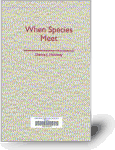![]()

When species meet
Donna J. Haraway
abstract
In 2006, about 69 million U.S. households had pets, giving homes to around 73.9 million dogs, 90.5 million cats, and 16.6 million birds, and spending over $38 billion dollars on companion animals. As never before in history, our pets are truly members of the family. But the notion of "companion species"-knotted from human beings, animals and other organisms, landscapes, and technologies-includes much more than "companion animals."
In "When Species Meet", Donna J. Haraway digs into this larger phenomenon to contemplate the interactions of humans with many kinds of critters, especially with those called domestic. At the heart of the book are her experiences in agility training with her dogs Cayenne and Roland, but Haraway's vision here also encompasses wolves, chickens, cats, baboons, sheep, microorganisms, and whales wearing video cameras. From designer pets to lab animals to trained therapy dogs, she deftly explores philosophical, cultural, and biological aspects of animal-human encounters.
In this deeply personal yet intellectually groundbreaking work, Haraway develops the idea of companion species, those who meet and break bread together but not without some indigestion. "A great deal is at stake in such meetings," she writes, "and outcomes are not guaranteed. There is no assured happy or unhappy ending-socially, ecologically, or scientifically. There is only the chance for getting on together with some grace."
Ultimately, she finds that respect, curiosity, and knowledge spring from animal-human associations and work powerfully against ideas about human exceptionalism.
keywords
animal habit&behaviour, animal-human relationship, companion species, cyberfeminism
catalogue card
Title: When species meet
Author: Donna J. Haraway
Publication: Minneapolis: University of Minnesota, cop. 2008
Matèries: man and animals
ISBN: 978-0-8166-5045-3, 0-8166-5045-4
index
 The texts published in this journal, unless otherwise indicated, are subject to a Creative Commons Attribution-Noncommercial-NoDerivativeWorks 2.5 licence.
It may be copied, distributed and broadcast provided that the author and UOC Papers are cited. Commercial use and derivative works are not permitted. The full licence can be consulted on http://creativecommons.org/licenses/by-nc-nd/2.5/es/deed.en
The texts published in this journal, unless otherwise indicated, are subject to a Creative Commons Attribution-Noncommercial-NoDerivativeWorks 2.5 licence.
It may be copied, distributed and broadcast provided that the author and UOC Papers are cited. Commercial use and derivative works are not permitted. The full licence can be consulted on http://creativecommons.org/licenses/by-nc-nd/2.5/es/deed.en





